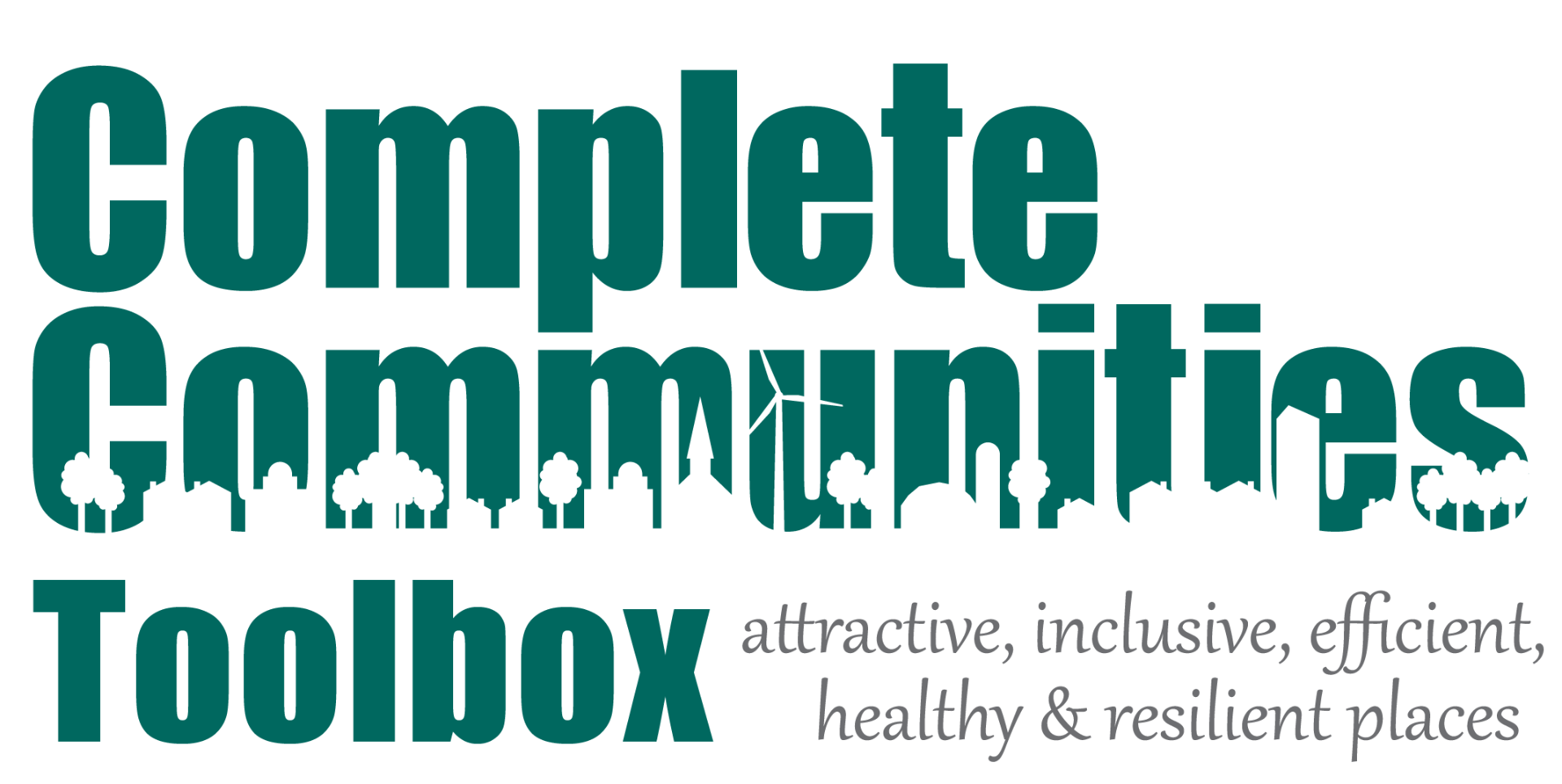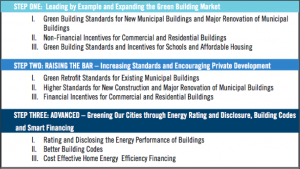This section introduces the concept of green building practices. It explains how green building strategies may be used by local governments to design and build healthy, comfortable, cost efficient and environmentally friendly living and working environments. Local governments can incorporate green building practices into their planning and policy framework as a foundation for resource efficiency, a green economy, and sustainable development.
Topics in this section include:
- What is a Green Building Practice?
- Guiding Principles of Green Building Practices
- Green Building as a Complete Communities Best Practice
- Benefits of Green Building Practices
- State-Level Green Building Initiatives in Delaware
- Instituting Green Building Practices in Your Community
- Delaware Local Government Green Building Practices and Initiatives in Delaware
What is a Green Building Practice?
Definition of Green Building
Green buildings, as defined by the International City/County Management Association (ICMA), is an integrated approach to designing and building healthy, comfortable, cost effective, and environmentally friendly living and working environments. Green building practices are primarily focused on developing sustainable sites, increasing water and energy efficiency, reducing waste and emissions, using eco-friendly building materials, and improving indoor environmental quality more efficiently than conventional designs.
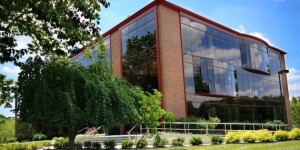
DuPont’s Experimental Station in Wilmington was awarded the LEED Existing Building Certification by the U.S. Green Building Council, Source: DuPont
Energy inefficient commercial and residential buildings have led to increasing environmental concerns that have negative impacts on community sustainability. According to a report by the U.S. Energy Information Administration (EIA), these buildings are responsible for one-third of the greenhouse gas emissions in the United States, as well as approximately one-third of the energy and two-thirds of electricity. Through an integrated approach, local governments have the opportunity to change the way buildings operate, while fostering economic development, protecting the environment, and promoting the foundation for a sustainable community.
Guiding Principles of Green Building Practices
More states and local governments are taking action to incorporate green building techniques into their planning and policy framework as a foundation for resource efficiency, a green economy, and sustainable development. According to a report by the University of Delaware’s Center for Energy and Environmental Policy, seventeen states have adopted legislation to promote green building and design. The report also cites examples of cities that have adopted green building policy platforms to encourage construction of LEED-certified buildings and structures that maximize energy efficiency, conserve water, manage or recycle waste, and preserve local environments. LEED, or Leadership in Energy & Environmental Design, is a green building certification program that recognizes best-in-class building strategies and practices.
In addition, the National Association of Home Builders (NAHB) teamed with the International Code Council (ICC) to establish a nationally recognized standard for green building. The 2012 ICC 700 National Green Building Standard is now being used to guide green building across the residential building industry. ENERGY STAR, established by the U.S. Environmental Protection Agency (EPA) in 1992, is voluntary program designed to identify and promote energy–efficient products and buildings in order to reduce energy consumption, improve energy security, and reduce pollution. Many states, including Delaware, and local governments are incorporating ENERGY STAR into their energy efficiency programs and policies.
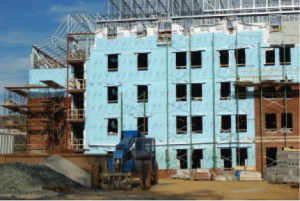
University of Delaware’s Laird Campus, Source: Responsible Energy Code Alliance
Green building practices can serve a variety of purposes and are often categorized into multi-faceted designs and approaches that are beneficial for both communities and businesses. Both policy professionals and the building industry have categorized green building principles to help guide future development and design. The five principles of green building practices have been established that are organized around the life cycle performance of green buildings. An integrated and comprehensive approach, the principles encompass each of the green building phases, including construction, operation, maintenance, and decommissioning.
- Sustainable Siting—this approach optimizes land use and development to reduce adverse impacts and minimize the building’s ecological footprint.
- Energy Efficiency—this technique focuses on the establishment of performance targets that account for intended use, occupancy and other energy operations for new construction and renovation projects.
-
Water efficiency— this technique emphasizes the value of decreasing demands for fresh water and reducing the generation of wastwater through optimized landscaping, integrated rainwater cathments, gray water recycling, and wastewater treatment systems.
- Building Materials—by using sustainable construction materials and resources, green building materials have aided the reduction of extraction, processing, transportation, solid waste, and consumption.
- Healthy Indoor Environmental Quality—these processes have enhanced the sustainable communities through ventilation and thermal comfort, moisture control, daylighting, environmental tobacco smoke control, and protecting indoor air quality during construction.
Green principles remain a critical component of sustainable development and have developed environmentally sound technologies, designs, and buildings. Because the green building field is rapidly evolving, state and local governments will need to keep abreast of changes to green building certification programs, rating systems, standards, and technology advancements.
Green Building as a Complete Communities Best Practice
As one of the five elements of a Complete Community, sustainable refers to communities that are planned, built, or modified to promote sustainable living. This may include sustainability aspects relating to reproduction, water, transportation, energy, waste, and materials. The commitment to environmentally friendly building practices generates opportunities for communities to promote sustainable living. Sound building principles play an important role in enhancing the community’s long-term economic, social, and environmental health, while supporting the safety, welfare, and quality of life of its citizens.
Today’s commitment to energy efficiency, sustainability, and protection has placed demands on local governments that oversee the construction of new buildings and the renovation of existing structures. The 2012 International Energy Conservation Code (IECC) is a model code designed to help conserve energy in both commercial buildings and residential structures while providing direction for safe and sustainable building design and construction. The 2015 version of the International Green Construction Code (IgCC) was recently adopted, which provides a regulatory framework that establishes minimum green building requirements for buildings and complementary rating systems, like LEED. Both model codes establish minimum or baseline sustainable design requirements for new and existing commercial buildings and residential structures. The IgCC is an “overlay” code, which means that it adds green provisions on top of existing codes, such as the International Building Code (IBC), IECC, and the other “I-Codes.” When adopted nationwide by states and local governments, IgCC will create a path to cut energy use by commercial buildings, a large consumer of energy. The American Institute of Architects (AIA) has created a guide to the IgCC.
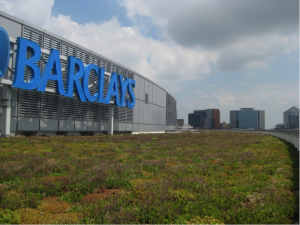
Green Roof installed at Barclays Building at Christiana Crescent in Wilmington, Delaware
Source: Rooflite
Increasingly, local governments are realizing the need to adapt to changing market demands for infill development, redevelopment, and development in areas targeted for growth that incorporates the design and construction of high-performance buildings. Incorporating sustainable practices, materials, and energy- efficient products saves energy and money while protecting the environment and creating a more comfortable, healthful environment. As demand for more energy-efficient buildings increases, governments will need to consider policy changes to reduce the negative impacts and increase the positive impacts of the built environment on the natural environment and local residents. Enacting sustainable building policies and practices can also reduce infrastructure needs and costs to communities and their residents.
Benefits of Green Building Practices
The current building environment has a major impact on the environment, economy, and public health of citizens. According to a report by the U.S. Environmental Protection Agency (EPA), buildings account for 39 percent of total energy use, 12 percent of total water consumption, 68 percent of total electricity consumption, and 38 percent of the carbon dioxide emissions. By adopting green building strategies, local governments can expand and improve upon local economic development opportunities and market demand for sustainable development.
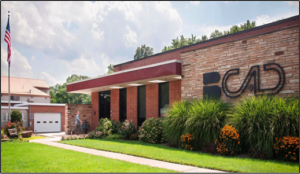
New Castle County-based Brandywine CAD is an example of adaptive reuse of the old Talleyville Post Office, which became an energy-efficient work space thanks to the Energy Department’s State Energy Program. Source: BCAD
The University of Delaware’s Center for Energy and Environmental Policy emphasizes that green building practices will continue to increase in order to meet the demands of the market. Potential benefits have been divided into three categories: economic, social, and environmental.
Economic
- Reduced costs for site preparation, building materials, and operational costs through sustainable siting
- Added market value of buildings
- Enhanced water efficiency practices leading to reduced annual water costs and municipal wastewater treatment costs
- Increased local economic development opportunities
- Enhanced energy efficiency practices leading to reduced peak power demand, reduced demand for new energy infrastructure, lower energy costs to consumers, and up to 70 percent lower annual fuel and electricity costs
- Longer lifetimes for buildings and equipment through smart commissioning practices
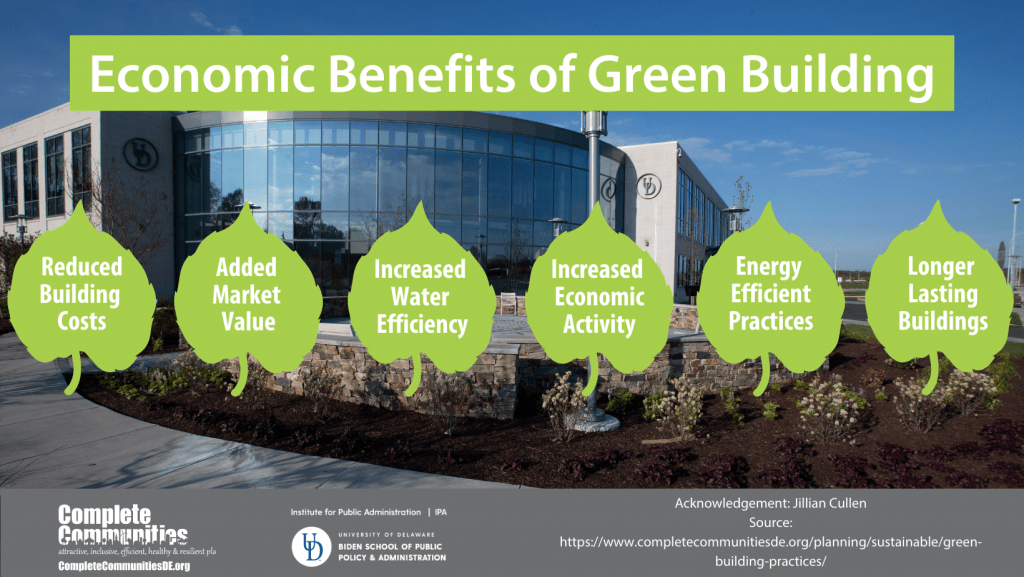
Social
- Equitable access to infrastructure services, such as transportation
- Fewer wastewater treatment plants and increased preservation efforts for water resources
- Fewer new power plants and transmission lines in community
- Expanded market for environmentally preferableproducts
- Improved occupancy satisfaction, comfort, and individual productivity
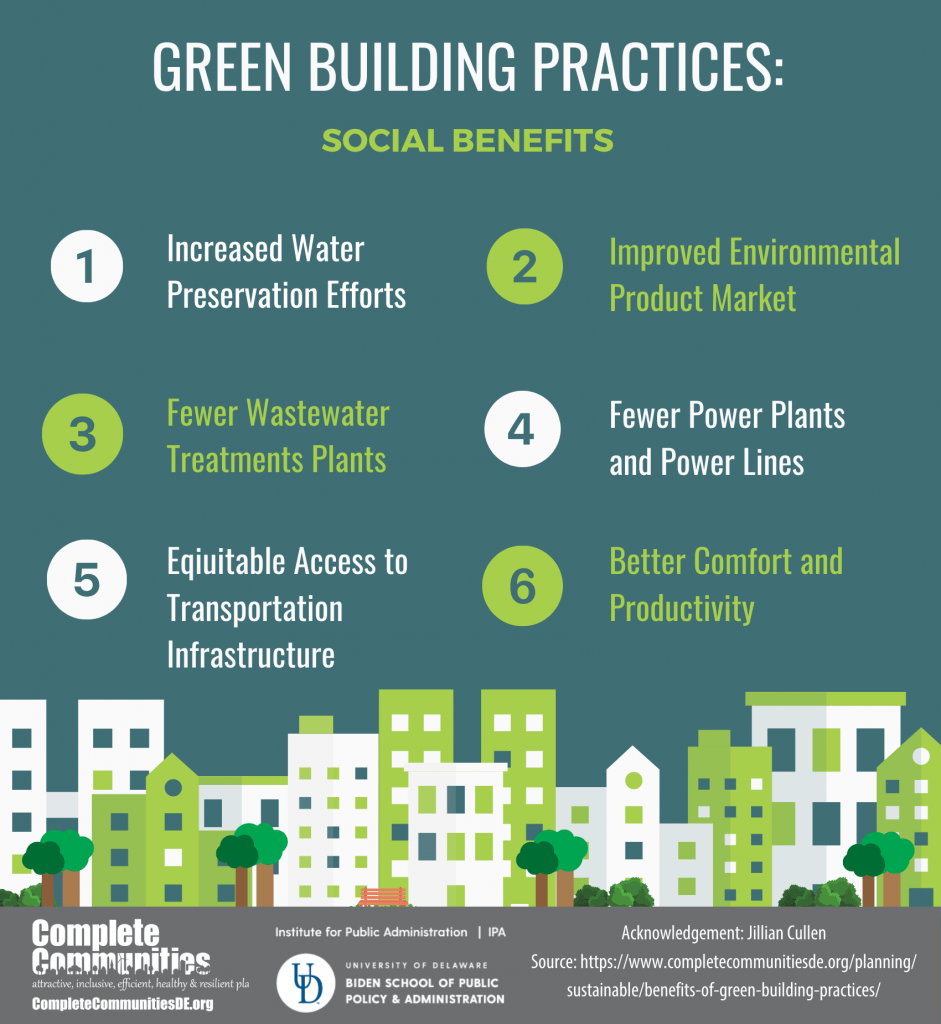
Environmental
- Assist in the conservation of environmental resources, while also reducing pollution levels, greenhouse gas emissions, and waste. The report cites a 2007 United Nations Environmental Program (UNEP) study which estimates that sustainable design and green buildings could result in as much as 1.8 billion tones/year of averted carbon dioxide emissions worldwide.
- Increased land preservation, lower resource and energy use, and the protection of ecological resources.
- Preservation of water resources for wildlife and agriculture.
- Lower electricity and fossil fuel use and decreased impacts of fossil fuel production.
- Improved indoor air quality and, in turn, reductions in air pollution levels.
State-Level Green Building Initiatives in Delaware
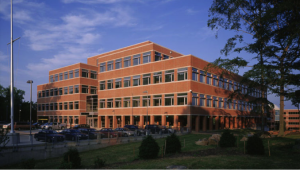
The J. Richard Carnall Center, at the site of the former DuPont Estate in Wilmington, Delaware, was redesigned and constructed to achieve LEED-NC v2.1 Gold certification. It now serve as PFPC’s new corporate headquarters
Source: Astorino
State Policy and Legislation
Many states, including Delaware, have passed legislation and developed initiatives focused on supporting sustainable energy investments and financial incentives. Executive Order 18, Leading by Example Towards a Clean Energy Economy & Sustainable Natural Environment, requires state agencies to take actions to address energy conservation and efficiency, use of renewable energy, environmentally responsible construction, recycling, clean transportation and environmentally sensitive procurement. The Executive Order directs the State’s Office Management and Budget (OMB) and DNREC to establish a plan to benchmark, monitor and track the energy use and carbon emissions of all State-owned and State-leased facilities. The State has chosen the ENERGY STAR Portfolio Manager tool as its benchmarking platform. In 2012, OMB’s Division of Facilities Management produced a progress report toward achieving goals of Executive Order 18. It documents measurable advancements by state agencies in in reducing pollution and waste, reducing government spending, developing clean energy jobs, and leading the private sector by example.
In 2011, the Delaware General Assembly passed HB 129 to establish an Energy Efficiency Investment Fund. Funding is provided to finance energy efficiency projects through competitive grants and low-interest loans, as well as reduce overall energy use and create jobs.
In 2013, the 147th Delaware General Assembly passed Senate Concurrent Resolution 34, which formally established a Green and Better Building Advisory Committee in Delaware. This legislation, supported by the Delaware Valley Green Building Council (DVGBC), brings together a diverse group of public and private sector individuals with expertise in sustainable building design to advise the Delaware General Assembly and the Governor. This Committee found that green building designs and construction can save as much as 30% or more on energy costs for Delaware. In July 2014, the 148th Delaware General Assembly passed Senate Concurrent Resolution 67 to augment the Committee with additional members from professional organizations representing the building industry.
Codes
Delaware’s Code for Energy Conservation provides a legal basis for green building of residential dwellings. The Delaware Energy Office, in consultation with the Green Building Council of the Home Builders Association of Delaware, is promoting the construction “zero-net energy” homes and buildings. These structures use energy-efficient construction, lighting, appliances and on-site renewable energy generation that result in zero-net energy consumption from the utility provider. All new residential and commercial building construction in the State of Delaware must be zero-net energy capable by December 31, 2025 and December 31, 2030 respectively.
OMB’s Division of Facilities Management, in coordination with the Division of Energy & Climate, utilized the U.S. Department of Energy’s Energy Efficiency & Conservation Block Grant (EECBG) to implement energy efficiency improvements at several state-owned facilities. Delaware has already made progress to ensure that LEED design principles are implemented for resource efficiency and environmental sensitivity. Currently, the certification process is underway at the Carvel State Office Building in Wilmington, as well as the Richardson and Robbins Building in Dover.
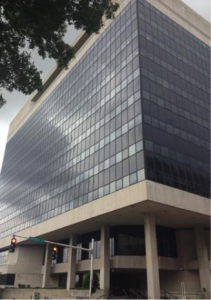
In 2012, the Carvel State Office Building in Wilmington began implementing larger-scale energy conservation measures (ECMs) and low-/no-cost energy changes to save 26 percent on its annual energy usage and $225,000 annually in energy costs.
Source: U.S. Department of Energy
Programs
The Delaware Department of Natural Resources and Environmental Control’s (DNREC) Division of Energy & Climate has taken the lead on providing information on green building incentives in Delaware. Under Delaware’s Green Energy Program, grant incentives are provided for qualifying renewable energy systems installed in the state. The Delaware Electric Cooperative offers grants through the Renewable Resource Program to offset the installed cost of photovoltaic, solar water heating, wind, and geothermal renewable energy systems. Member-owners and contractors may apply for grants through the Division of Energy & Climate. Municipal Green Energy grants, administered by the Division of Energy & Climate, are also available to encourage and support renewable energy technologies. Availability is limited to electric customers of several Delaware municipal electric utilities that are contributing to the Municipal Green Energy Fund. The Delaware Municipal Electric Cooperation (DEMEC) has published a Municipal Utilities’ Green Energy Fund Program guide that describes the program’s provisions and eligibility.
Electric Vehicle Charging Stations
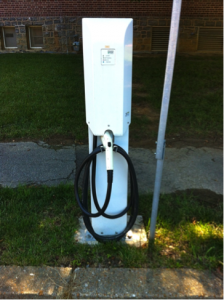
An electric vehicle charging stations at the Lewes Terminal of the Cape May – Lewes Ferry
Source: Delaware River Bay Authority
A collaborative research agreement between the University of Delaware (UD) and the Delaware Department of Natural Resources and Environmental Control (DNREC) initiated a “Charging Up Delaware” program in 2014. The program is designed to promote a network of electric vehicle charging stations to facilitate long-distance trips with electric vehicles within the State. It is hoped that these charging stations will support greater use of electric vehicles, which do not release air pollution or carbon dioxide, unlike gasoline-fueled vehicles. In August 2014, the City of Rehoboth Beach commissioners approved a pilot program to install high-speed electric vehicle charging stations at two downtown parking spots through the Charging Up Delaware program. In November 2014, Delaware River and Bay Authority (DRBA) officials announced plans to install two electric vehicle charging stations at the Lewes Terminal of the Cape May – Lewes Ferry. The charging stations will be provided free of charge to the DRBA through the Charging Up Delaware program.
Leadership
Created in June 2012, the Energy & Sustainable Leaders Roundtable engages businesses and development communities in energy use reduction and minimizing their environmental and carbon footprints. With AstraZeneca, Brightfields, and Barclays as several of the key members, the Roundtable is working toward its goal of sustainable building construction and operation.
Instituting Green Building Practices in Your Community
Local governments can adapt their policies and regulations to provide a framework for green building practices and resilient options.
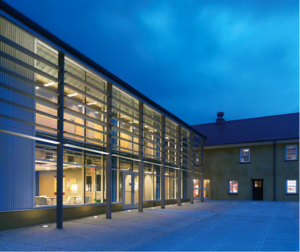
The renovation of the Blue Ball Dairy Barn in New Castle County achieves a balance of historic preservation, high design, and sustainability. Source: Atelier Ten
Planning
Many municipalities are incorporating a vision of sustainability into local government Comprehensive Plans, which guide future land use and development. Some Comprehensive Plans call for transit-oriented development, compact development patterns, and environmental stewardship strategies to reduce environmental impacts of motorized vehicles, minimize sprawl, and conserve natural resources. Other plans set forth a vision for new buildings to achieve STAR ENERGY efficiency standards, LEED certification, or an equivalent green building standard. Many Comprehensive Plans also provide a foundation for stormwater management practices, resource conservation, and low-impact development techniques such as green roofs, rain gardens, minimization of impervious covers, adaptive reuse of buildings, use of recycled materials, streetscaping, and use of renewable energy resources.
The Town of Edmonston, Maryland transformed its vision and plan for environmental sustainability into a “green street” project that is designed to provide transportation options, a pedestrian- and bicycle-friendly environment, and minimize rainwater runoff and flooding. Its main residential street incorporates environmentally responsible practices such as stormwater bio retention and filtration, energy-efficient street lighting, native street trees, permeable concrete, ADA-compliant sidewalks, marked bike lanes, and traffic-calming measures.
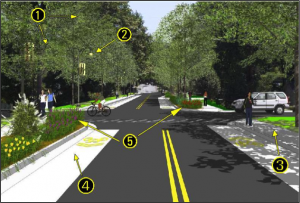
Edmonston, Md.’s Green Street Project. Source: Town of Edmonston, Md.
Regulations
Zoning codes often conflict with attempts by developers to design buildings with green materials or energy-efficient features. Local governments should review and amend regulations to remove zoning code impediments to the construction and retrofitting of green buildings. Green building policies can be incorporated into zoning codes and other development regulations, such as stormwater and subdivision ordinances. The City of Boston was the first city in the nation to require a green building standard through municipal zoning requirements. Its code requires all large-scale building projects to meet the U.S. Green Building Council’s LEED certificate standards. The City of Baltimore’s building code mandates that all newly constructed, extensively modified non-residential, and specific multi-family residential buildings, that have or will have at least 10,000 square feet of gross floor area, must be LEED Silver certified or comply with the Baltimore City Green Building Standard. In addition, Baltimore has drafted a new zoning code that incorporates sustainability measures and allows green-building friendly practices such as solar power, wind power, green roofs, bike parking, transit-oriented development districts, and parking space/lot size reductions.
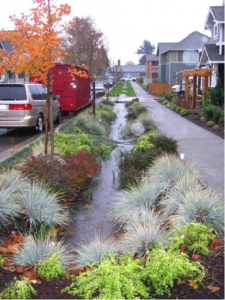
Credit: Clarion Associates Source: EPA.gov
Building Codes
Many local governments are adopting green building practices that include new building certifications, codes, rating systems, and performance measures. There is widespread local government adoption of the voluntary U.S. Green Building Council’s (USGBC) Leadership in Energy and Environmental Design (LEED) rating system, which has assisted in the development of defining best practices for green buildings.
The development, adoption, and implementation of building codes are essential to any successful energy policy. Building codes create easy-to-understand minimum requirements for all new construction. Local governments can adopt model codes and adapt their regulatory framework to encourage green building construction and cultivate responsible environmental management practices.
Instead of, or in addition to LEED, states and local governments are also adopting national model energy codes. As of November 11, 2014, the State of Delaware requires all new homes and commercial buildings to comply with the 2012 International Energy Conservation Code (IECC). Local governments may also consider adoption of the International Green Construction Code (IgcC). At a time when the industry engagement of green buildings is gaining popularity, these codes recognize the need for a competitive marketplace, new building codes, performance measures, and additional rating systems.
Incentives
There are a variety of green building incentives that local governments may consider to attract infill development, redevelopment, and development in targeted growth areas within in their communities. An increasingly-popular technique for local governments has been the introduction of market-driven incentives to attract large businesses and develop partnerships. Most notable for their advancements in the sustainable infrastructure is Portland, Oregon that has developed a Green Investment Fund, offering grants of various sizes to commercial, industrial, residential, and mixed-use entities. A policy brief by the American Institute of Architects notes that states and local green building incentives may also include:
- Tax Incentives—to provide tax reductions for specific levels of green measures and certification;
- Density/Floor Area Ratio Bonuses—that offer height bonuses, floor/area ratio bonuses, reductions in landscaping requirements, and count green roof space as landscaping/open space in exchange for achieving levels of green building rating; and
- Expedited Permitting—to provide streamlined permitting processes for projects that attain high levels of sustainability
- Reduced-cost building permits – to provide financial incentives for green building initiatives
Technical Assistance
Potential investments in green building technology require an understanding of the materials and proper training. Many cities and counties have made it a priority to introduce technical assistance programs, which have aided the outreach and marketing process for governments considering investments in the sustainable industry. The Environmental Protection Agency’s smart growth recommendations include Building Blocks for Sustainable Communities, focusing on technical assistance as a means to introduce and achieve development goals toward more sustainable infrastructure. Communities of all sizes can apply for the EPA’s technical assistance program and will receive information from experts on public engagement, direct consultation, and action-oriented steps. Among the tools included is a recommendation for a Green Building Toolkit, which assists local governments in identifying policies that support the development of sustainable homes and buildings. In February 2013, New Castle was selected to receive Building Blocks assistance on sustainable strategies for small cities and rural areas.
Increased Standards
Local governments can take expand green building in their community by incorporating green building techniques in municipal buildings, increasing standards for private development, and establishing better building codes and instituting performance-oriented rating systems. This graphic illustrates U.S. Green Building Council’s three-step approach for municipalities to encourage green building in their communities.
Delaware Local Government Green Building Practices and Initiatives in Delaware
Energy-Efficient Buildings

The Paul Sweeney Public Safety Building in New Castle County, Del. Source: Schradergroup Architecture
In 2010, Delaware’s three counties and ten largest municipalities received federal Energy Efficiency and Conservation Block (EECBG) grants directly from the U.S. Department of Energy as part of the American Recovery and Reinvestment Act of 2009. In addition, 21 Sussex County towns received EECBG in 2011 funds to make energy-saving improvements to municipal buildings. The grants, awarded, were expected to save the towns an estimated total of nearly $250,000 in annual energy costs. The grants provided for reduced energy consumption and costs for municipal buildings including heating and cooling efficiency upgrades, lighting retrofits, window upgrades, insulation additions, pump upgrades, solar energy installations and a white roof project. Through the EECBG, 15 Delaware municipalities, including the Town of Ocean View, have installed solar power systems on their municipal buildings.
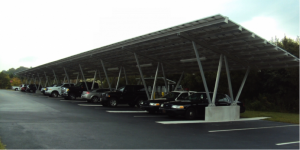
With a grant from the Energy Department’s Energy Efficiency and Conservation Block Grant Program, the Town of Ocean View, Del., installed a carport-mounted solar array that is saving taxpayers money on town utility bills.
Photo credit: Town of Ocean View
Source: Energy.gov
Solar-Powered Municipal Facilities
According to a report by the Environment America Research and Policy Center, the state of Delaware’s leadership, energy legislation, strong public policies, and innovative financing options have made the state a leader in solar energy. The Delaware Municipal Electric Corporation (DEMEC), a wholesale electric utility and its nine-member municipalities, have collectively invested in Delaware’s largest PV facilities. The Milford Solar Farm generates more than 13 MW and the Dover Sun Park generates 10 MW. Wilmington, Dover, and Kent and New Castle County governments have installed solar power on their office and public works facilities. The City of Newark is currently installing a 230 kW solar array at its municipal building.

